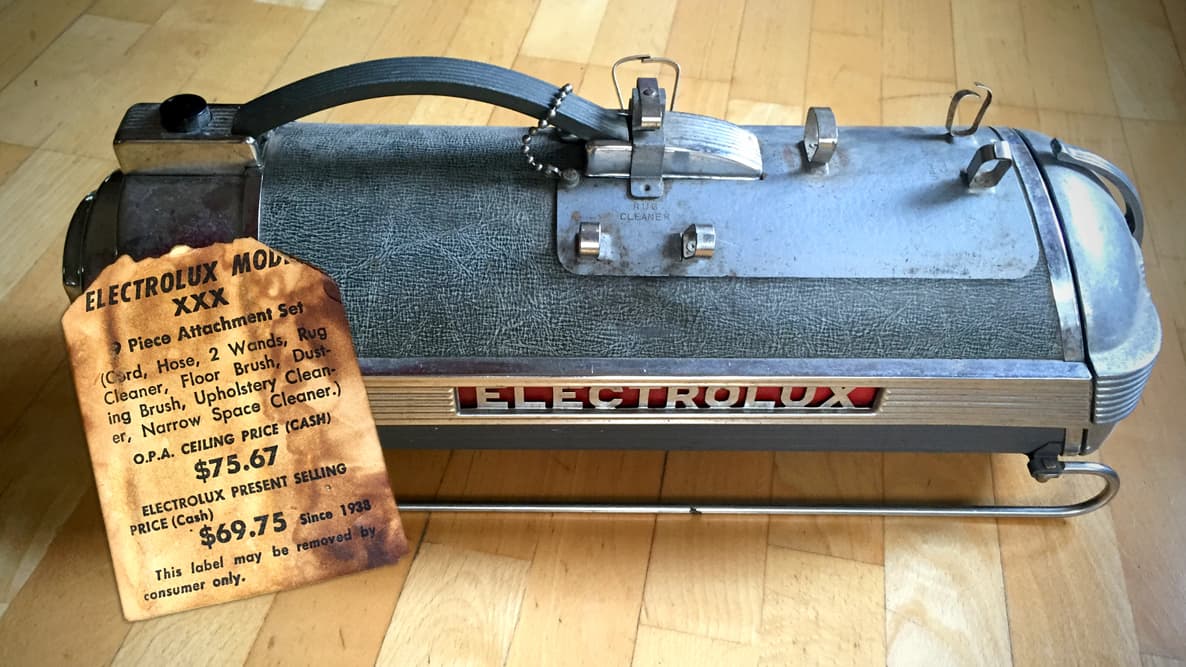Suck up, tear down
An Electrolux from the '50s inspires a head-to-head comparison with a Dyson Animal. Let's just say there are some trade-offs.
Suck up, tear down
A neighbor of mine left this stunning post-war (~1950) Electrolux XXX at their curb. I snatched it, immediately hoping to convert it to a table lamp. I was blown away by the industrial design and the workmanship.
It turns out this model was
produced for 25 years, designed by Lurelle Guild. This design was probably his
most famous design, echoing Art Deco trains of the era.
How does this legendary
design stack up with the Dyson that’s sitting in my broom closet? The corded
Animal from a few years back was the must-have vacuum created by the industrial
design and marketing legend James Dyson.
At first, I bemoaned how consumer products have evolved. Knee jerk stuff really:
Then… durable materials
Now... cheap materials
Then… timeless designs
Now… forcing trendy ones
Then… selling an investment
Now… creating demand for the new model
Upon further review, I do still feel those things. It’s worrisome that the economy demands constant consumption where I “need” a new vacuum every five years instead of every 25. But fairness demands that I give each product a close look and consider how successful they are in achieving their goals.
Design
The Art Deco style of the Electrolux started in art and evolved into architecture and design. It uses symmetry and linearity and made a bold technology-first statement. It is strongly ornamented, which can become tacky. Ornamentation is at odds with “form follows function” seen in more modern designs. In the case of this vacuum, some of the embellishments could mar furniture legs and the nameplate is a difficult-to-clean dirt trap.
Dyson’s overall design is recognizable with its use of bright color and primitive forms (circles mostly). It has an overall toy-like appearance with oversized user touch points. But the design is mainly driven by spotlighting the technology (in this case the cyclone suction elements) and by dialing in the human factors (great affordances for doing everything from unlocking the vacuum to pulling out the wand to snapping in the attachments). Dyson recognizes that they want you to love your vacuum today so they smash as many trends into it as possible, but you will likely tire of it tomorrow so they don’t worry about picking a color you will hate in three years.
The branding is interesting to compare. Both companies want you to see their brand on the shelf. But the Electrolux uses the badge as a major design element, putting it in the main horizontal with a stamped out metal badge above a red field. Dyson simply pad prints their name on the plastic in a couple of spots, a sign that they were fighting for every penny to hit their price point.
Usability
This is an unfair comparison since I’ve never actually used the Electrolux, but there are a few touchpoints I can evaluate. This is a well-considered machine. The bag access has a large lever that opens a door. There are finger cutouts for grabbing the bag and the bag slides out easily.
The accessories mount to the top (they are all missing) and
are accessible. The clips they snap into are sharp, though.
The Dyson has some details
that I love to refer to during brainstorms. This is high praise. They get so
many things right. At the top of my list is the cord release, a satisfying
swiveling finger that snaps into position both up and down
Another feature I love is the
trash canister. It doesn’t require a bag and doesn’t clog (basically the main
marketing feature of Dyson early on). It pops off of the vacuum easily and
releases reliably into the trash from the bottom. It does exactly what you need
it to do.
Manufacturing processes and materials
Today’s engineers and designers have SOOO many choices in materials and processes when designing a product. But inevitably if you are designing a high-volume product it’s probably going to be injection molded. The consistency of the parts, the scalability of the volumes, and the performance of the material is really unmatched. Price points can be differentiated with a sparing use of genuine materials like metal or wood but these often get priced out. In 1937, when the Electrolux started in production, molding was very specialized. It wasn’t until the ‘40s that the screw injection machine was invented. There are three obviously molded parts on the Electrolux – the power button (likely a thermoset like Bakelite), the upper housing (sheet material) and the handle (a molded rubber). The rest of the components are die cast aluminum and stamped steel. The thing weighs a ton.
Functionally and economically, the plastic Dyson materials are far superior. The environmental impact is really beyond my expertise. It is possible that if you ignored a bunch of stuff like shipping, the two units would consume a similar amount of energy to produce. But it is not debatable that the chances of finding a Dyson Animal on the side of a road in 2080 are about the same as the chances you’ll find a college kid using a flip phone. The impact shouldn’t be Electrolux vs. Dyson. It should be Electrolux vs. five Dysons.
And I’m going to have one bad-ass lamp sometime soon.
This article was written by Jesse Darley.
